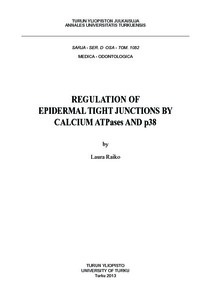Regulation of epidermal tight junctions by calcium ATPases and p38
Raiko, Laura (2013-09-06)
Regulation of epidermal tight junctions by calcium ATPases and p38
Raiko, Laura
(06.09.2013)
Annales Universitatis Turkuensis D 1082 Turun yliopisto
Julkaisun pysyvä osoite on:
https://urn.fi/URN:ISBN:978-951-29-5450-6
https://urn.fi/URN:ISBN:978-951-29-5450-6
Kuvaus
Siirretty Doriasta
ei tietoa saavutettavuudesta
ei tietoa saavutettavuudesta
Tiivistelmä
The epidermis is the upper layer of the skin and keratinocytes are its most abundant cells.
Tight junctions are cell junctions located in the granular layer of the epidermis. They
maintain the polarity of the cells and regulate the movement of water-soluble molecules.
Epidermal tight junctions may lose their integrity when there are defects in intercellular
calcium regulation. Hailey-Hailey and Darier´s disease are dominantly inherited, blistering
skin diseases. Hailey-Hailey disease is caused by mutations in the ATP2C1 gene encoding
a calcium/manganese ATPase SPCA1 of the Golgi apparatus. Darier´s disease is caused by
mutations in the ATP2A2 gene encoding a calcium ATPase SERCA2 of the endoplasmic
reticulum. p38 regulates the differentiation of keratinocytes. The overall regulation of
epidermal tight junctions is not well understood. The present study examined the regulation
of tight junctions in the human epidermis with a focus on calcium ATPases and p38. Skin
from Hailey-Hailey and Darier´s disease patients was studied by using
immunofluorescence labeling which targeted intercellular junction proteins.
Transepidermal water loss was also measured. ATP2C1 gene expression was silenced in
cultured keratinocytes, by siRNA, which modeled Hailey-Hailey disease. Expression of
intercellular junction proteins was studied at the mRNA and protein levels. Squamous cell
carcinoma and normal human keratinocytes were used as a model for impaired and normal
keratinocyte differentiation, and the role of p38 isoforms alpha and delta in the regulation
of intercellular junction proteins was studied. Both p38 isoforms were silenced by
adenovirus cell transduction, chemical inhibitors or siRNA and keratinocyte differentiation
was assessed.
The results of this thesis revealed that: i.) intercellular junction proteins are expressed
normally in acantholytic skin areas of patients with Hailey-Hailey or Darier´s disease but
the localization of ZO-1 expanded to the stratum spinosum; ii.) tight junction proteins,
claudin-1 and -4, are regulated by ATP2C1 in non-differentiating keratinocytes; and iii.)
p38 delta regulates the expression of tight junction protein ZO-1 in proliferating
keratinocytes and in squamous cell carcinoma derived cells. ZO-1 silencing, however, did
not affect the expression of other tight junction proteins, suggesting that they are differently
regulated.
This thesis introduces new mechanisms involved in the regulation of tight junctions
revealing new interactions. It provides novel evidence linking intracellular calcium
regulation and tight junctions.
Tight junctions are cell junctions located in the granular layer of the epidermis. They
maintain the polarity of the cells and regulate the movement of water-soluble molecules.
Epidermal tight junctions may lose their integrity when there are defects in intercellular
calcium regulation. Hailey-Hailey and Darier´s disease are dominantly inherited, blistering
skin diseases. Hailey-Hailey disease is caused by mutations in the ATP2C1 gene encoding
a calcium/manganese ATPase SPCA1 of the Golgi apparatus. Darier´s disease is caused by
mutations in the ATP2A2 gene encoding a calcium ATPase SERCA2 of the endoplasmic
reticulum. p38 regulates the differentiation of keratinocytes. The overall regulation of
epidermal tight junctions is not well understood. The present study examined the regulation
of tight junctions in the human epidermis with a focus on calcium ATPases and p38. Skin
from Hailey-Hailey and Darier´s disease patients was studied by using
immunofluorescence labeling which targeted intercellular junction proteins.
Transepidermal water loss was also measured. ATP2C1 gene expression was silenced in
cultured keratinocytes, by siRNA, which modeled Hailey-Hailey disease. Expression of
intercellular junction proteins was studied at the mRNA and protein levels. Squamous cell
carcinoma and normal human keratinocytes were used as a model for impaired and normal
keratinocyte differentiation, and the role of p38 isoforms alpha and delta in the regulation
of intercellular junction proteins was studied. Both p38 isoforms were silenced by
adenovirus cell transduction, chemical inhibitors or siRNA and keratinocyte differentiation
was assessed.
The results of this thesis revealed that: i.) intercellular junction proteins are expressed
normally in acantholytic skin areas of patients with Hailey-Hailey or Darier´s disease but
the localization of ZO-1 expanded to the stratum spinosum; ii.) tight junction proteins,
claudin-1 and -4, are regulated by ATP2C1 in non-differentiating keratinocytes; and iii.)
p38 delta regulates the expression of tight junction protein ZO-1 in proliferating
keratinocytes and in squamous cell carcinoma derived cells. ZO-1 silencing, however, did
not affect the expression of other tight junction proteins, suggesting that they are differently
regulated.
This thesis introduces new mechanisms involved in the regulation of tight junctions
revealing new interactions. It provides novel evidence linking intracellular calcium
regulation and tight junctions.
Kokoelmat
- Väitöskirjat [3022]
